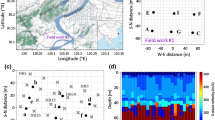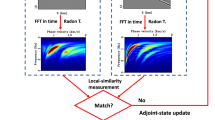Abstract
In petroleum seismic exploration, dense seismic ray coverage is often guaranteed through dense seismic sources and geophones. Dense ray coverage facilitates the high-resolution 3D velocity structure imaging of near surfaces using surface waves. In this study, the 3D velocity and anisotropy structure of a petroleum exploration area are obtained using the azimuth-dependent dispersion curve inversion (ADDCI) method. Imaging results show that low-velocity zones correspond to a river channel. The fast propagation direction (FPD) of S-waves along this channel is basically consistent with the direction of the channel. The eastern part of the study area has a surface sediment layer with a thickness of less than 20 m, which corresponds to the sand and gravel deposits formed by the river alluvial deposition near the surface. In addition, a relatively thick sedimentary layer is formed on the southern side of the study area. The anisotropy shows that the FPD is positively correlated with the direction of alluvial flow and that the magnitude of anisotropy in the deep part is greater than that in the shallow part. Inversion results are basically consistent with the geological data and suggest that the obtained model can truly reflect the 3D velocity structure and anisotropy of the near-surface area. This study shows that the ADDCI method can maximize the high-energy surface waves in exploration data to obtain near-surface velocity structures, which provide a highly accurate model for near-surface static correction.
Similar content being viewed by others
References
Aki, K., 1957, Space and time spectra of stationary stochastic waves, with special reference to microtremors: Bulletin of the Earthquake Research Institute, 39(3), 415–456.
Bensen, G. D., Ritzwoller, M. H., Barmin, M. P., et al., 2010, Processing seismic ambient noise data to obtain reliable broad-band surface wave dispersion measurements: Geophysical Journal of the Royal Astronomical Society, 169(3), 1239–1260.
Brune, J. N., and Pomeroy, P. W., 1963, Surface wave radiation patterns for underground nuclear explosions and small-magnitude earthquakes: Journal of Geophysical Research, 68(17), 5005–5028. doi: https://doi.org/10.1029/jz068i017p05005.
Capon, J., 1969, High-resolution frequency-wavenumber spectrum analysis: Proceedings of the IEEE, 57(8), 1408–1418.
Cheng, F., Xia, J. H., Luo, Y., et al., 2016, Multichannel analysis of passive surface waves based on crosscorrelations: Geophysics, 81(5), EN57–EN66.
Cheng, S., Tian, G., and Shi, Z. J., 2007, Studying surface structure in desert areas using multiple kinds of surface wave data: Applied Geophysics, 4(1), 1–7.
Feng, C. C., and Teng, T. L., 1983, Three2dimensional crust and upper mantle structure of the Eurasian Continent: Journal of Geophysical Research, 88, 2261–2273.
Herrmann, R. B., 2013, Computer programs in seismology: an evolving tool for instruction and research: Seismological Research Letters, 84(6), 1081–1088.
Hua, Q., Liang, C. T., Yang, Y. H., et al., 2020, Study on ambient seismic noise tomography of eastern Tibetan Plateau based on simulated annealing method: Chinese Journal of Geophysics (in Chinese), 63(5), 1787–1801.
Liang, C. T., and Langston, C.A., 2008, Ambient seismic noise tomography and structure of eastern North America: Journal of Geophysical Research: Solid Earth, 113, 1–19. doi: https://doi.org/10.1029/2007JB005350.
Liang, C. T., and Langston, C. A., 2009, Three-dimensional crustal structure of eastern North America extracted from ambient noise: Journal of Geophysical Research: Solid Earth, 114, 1–14. doi: https://doi.org/10.1029/2008JB005919.
Liang, C. T., Liu, Z. Q., Hua, Q., et al., 2020, The 3D seismic azimuthal anisotropies and velocities in the eastern Tibetan Plateau extracted by an azimuth, dependent dispersion curve inversion method: Tectonics, 39, 1–27. doi: https://doi.org/10.1029/2019TC005747.
Liang, C. T., Song, X. D., and Huang, J., 2004, Tomographic inversion of Pn travel times in China: Journal of Geophysical Research: Solid Earth, 109, 1–19. doi: https://doi.org/10.1029/2003JB002789.
Li, H. Y., Su, W., Wang, C. Y., and Huang, Z., 2009, Ambient noise Rayleigh wave tomography in western Sichuan and eastern Tibet: Earth and Planetary Science Letters, 282(1–4), 201–211. doi: https://doi.org/10.1016/j.epsl.2009.03.021.
Li, J. T., Song, X. D., Zhu, L. P., and Deng, Y. F., 2017, Joint inversion of surface wave dispersions and receiver functions with P velocity constraints: Application to Southeastern Tibet: Journal of Geophysical Research: Solid Earth, 122, 7291–7310. doi: https://doi.org/10.1002/2017JB014135.
Lin, R. B., Zeng, X. F., Song, Z. H., et al., 2020, Distributed Acoustic Sensing for imaging shallow structure I: Ambient noise tomography: Chinese Journal of Geophysics (in Chinese), 63(4), 1622–1629. doi: https://doi.org/10.6038/cjg2020N0272.
Li, Z. W., Ni, S. D., Zhang, B. L., Bao, F., Zhang, S. Q., Deng, Y., Yuen, D., 2016, Shallow magma chamber under the Wudalianchi volcanic field unveiled by seismic imaging with dense array: Geophysical Research Letters, 43, 4954–4961.
Liu, Z. Q., Liang, C. T., Hua, Q., et al., 2018, The seismic potential in the seismic gap between the Wenchuan and Lushan earthquakes revealed by the joint inversion of receiver functions and ambient noise data: Tectonics, 37, 4226–4238. doi: https://doi.org/10.1029/2018TC005151.
Lu, J., Wang, Y., and Yang, C. Y., 2010, Instantaneous polarization filtering focused on suppression of surface waves: Applied Geophysics, 7(1), 88–97.
Luo, Y. H., Xia, J. H., Miller, R. D., et al., 2008, Rayleigh-Wave Dispersive Energy Imaging Using a High-Resolution Linear Radon Transform: Pure & Applied Geophysics, 165(5), 903–922.
Luo, Y. H., Xia, J. H., Xu, Y. X., and Zeng, C., 2011, Analysis of group-velocity dispersion of high-frequency Rayleigh waves for near-surface applications: Journal of Applied Geophysics, 74(2), 157–165.
Miller, R. D., Xia, J. H., Park, C. B., Ivanov, J., 1999, Multichannel analysis of surface waves to map bedrock: The Leading Edge, 18, 1392–1396.
Park, C. B., Miller, R. D., Xia, J. H., and Ivanov, J., 2004, Imaging dispersion curves of passive surface waves: 74th Annual International Meeting, SEG, Expanded Abstracts, 1357–1360.
Park, C. B., Miller, R. D., and Xia, J. H., 1999, Multichannel analysis of surface waves: Geophysics, 64, 800–808.
Peng, W., 2007, Study about Investigation of Surface Layer Structure by Surface Wave Information in Petroleum Exploration: PhD Thesis, Chengdu University of Technology.
Santo, T., 1965, Lateral variation of Rayleigh wave dispersion character: Pure and Applied Geophysics, 62(1), 49–66. doi:https://doi.org/10.1007/bf00875287.
Song, Z., Zeng, X., Thurber, C., et al., 2018, Imaging shallow structure with active-source surface wave signal recorded by distributed acoustic sensing arrays: Earthquake Science, 31, 208–214.
Song, Z. H., Zeng, X. F., Xu, S. H., et al., 2020, Distributed Acoustic Sensing for imaging shallow structure I: active source survey: Chinese Journal of Geophysics (in Chinese), 63(2), 532–540.
Stokoe, II. K.H., and Nazarian, S., 1983, Effectiveness of ground improvement from spectral analysis of surface waves: Proceeding of the Eighth European Conference on Soil Mechanics and Foundation Engineering, Helsinki, Finland, pp, 91–95.
Thomson, W. T., 1950, Transmission of Elastic Waves through a Stratified Solid Medium: Journal of Applied Physics, 21(2), 89–93. doi:https://doi.org/10.1063/1.1699629.
Weaver R. L., 2005, Information from seismic noise: Science, vol. 307, pp. 1567–1568.
Xia, J. H., Miller, R. D., and Park, C. B., 1999, Estimation of near-surface shear-wave velocity by inversion of Rayleigh wave: Geophysics, 64(3), 691–700.
Xu, X. H., Qu, G. Z., Zhang, Y., et al., 2016, Ground roll separation of seismic data based on morphological component analysis in two dimensional domains: Applied Geophysics, 13(1), 116–126. doi:https://doi.org/10.1007/s11770-016-0546-0.
Yao, H. J., van der Hilst, R.D., and de Hoop, M.V., 2006, Surface-wave array tomography in SE Tibet from ambient seismic noise and two-station analysis: I — Phase velocity maps: Geophysical Journal International, vol. 166(2), 732–744. doi: https://doi.org/10.1111/j.1365-246X.2006.03028.x
Zeng, X., Lancelle, C., Thurber, C., et al., 2017, Properties of noise cross-correlation functions obtained from a distributed acoustic sensing array at Garner Valley, California: Bulletin of the Seismological Society of America, 107(2), 603–610. doi: https://doi.org/10.1785/0120160168.
Zhang, Y. S., and Tanimoto, T., 1992. Ridges, hotspots, and their interpretation as observed in seismic velocity maps: Nature, 355, 45–49.
Acknowledgments
The authors thank BGP and CNPC for providing the data and support and express their gratitude to the reviewers for their valuable comments.
Author information
Authors and Affiliations
Corresponding author
Additional information
Jiang Ningbo is currently pursuing his master’s degree from the College of Geophysics. Chengdu University of Technology, Sichuan, China. He received his B.S. degree in geophysics from Chengdu University of Technology (2018). His main research interest is surface wave tomography.
This work was supported by the National Key Research and Development Program of China (No. 2017YFC0601206), the Science and Technology Innovation (Seedling Project) Cultivation Program of Sichuan Province in 2020 (No. 2020127), and the National Natural Science Foundation of China (Nos. 41674059, 41340009).
Rights and permissions
About this article
Cite this article
Jiang, NB., Liang, CT. & Peng, W. Inversion of 3D velocity and anisotropy of near surfaces based on an azimuth-dependent dispersion curve inversion method. Appl. Geophys. 18, 213–225 (2021). https://doi.org/10.1007/s11770-021-0895-1
Received:
Revised:
Published:
Issue Date:
DOI: https://doi.org/10.1007/s11770-021-0895-1




